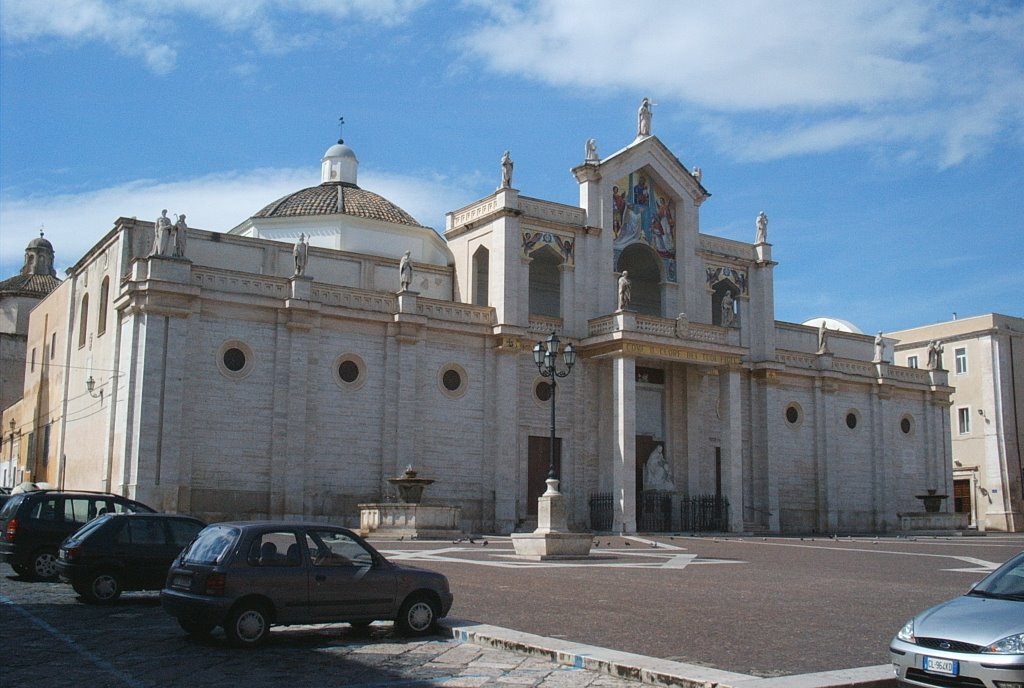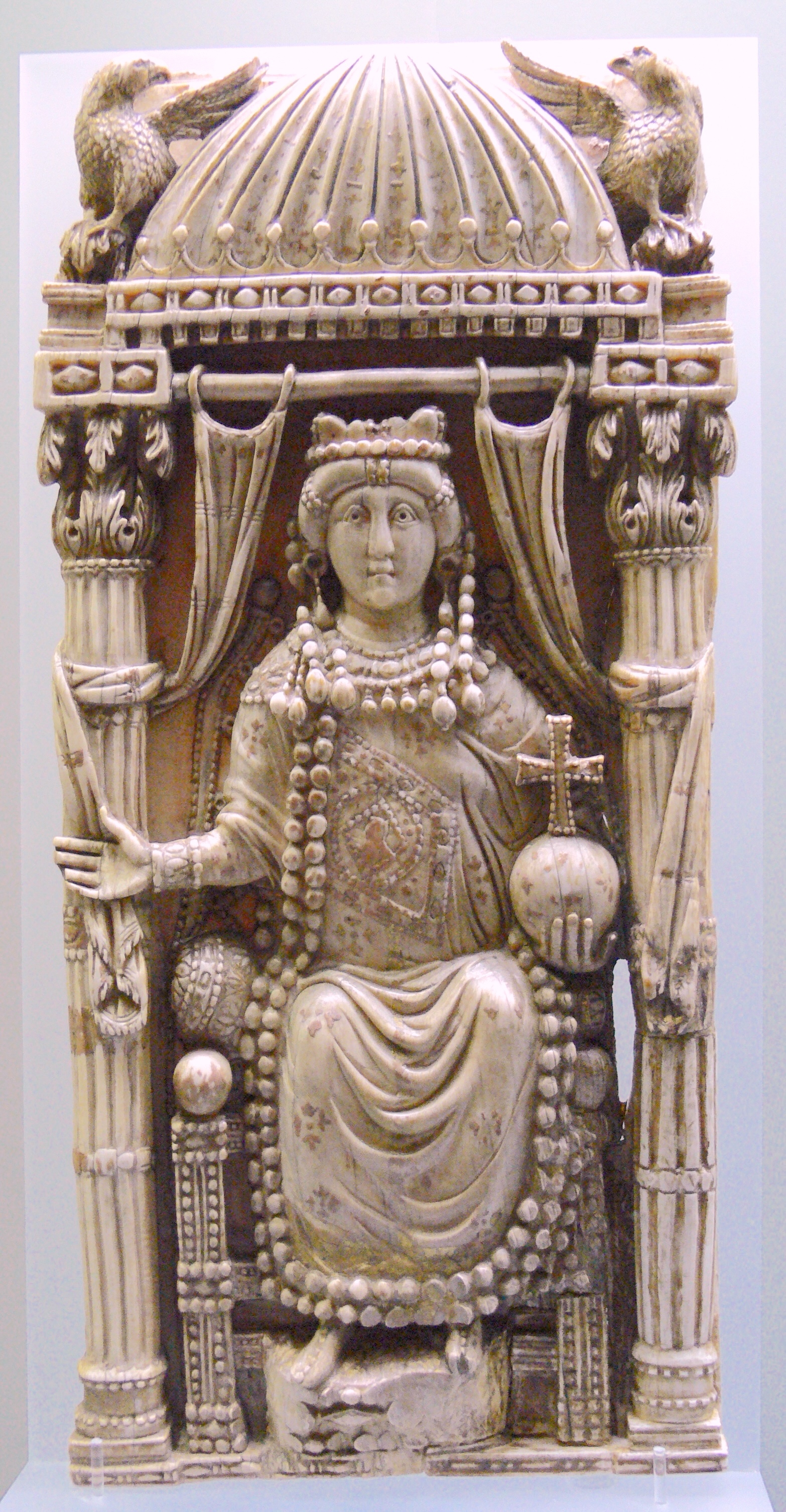|
Laurence Of Siponto
Laurence of Siponto, also known as Laurence Maioranus ( it, Lorenzo Maiorano) (d. 7 February, c. 545), is an Italian saint, patron of the city of Manfredonia and the Archdiocese of Manfredonia-Vieste-San Giovanni Rotondo. Manfredonia Cathedral is dedicated to him. He is credired with founded the shrine to Saint Michael the Archangel on Mount Gargano. Life According to a ninth century "vita", Laurence was from Constantinople. The bishopric of Siponto being vacant, the residents sent to Constantinople for a successor. Around 491 Emperor Zeno appointed his relative Laurence. It is not clear whether Laurence was consecrated bishop in Constantinople or in Rome by Pope Gelasius I. Laurence arrived in Siponto, bringing with him the relics of Saint Agatha and Saint Stephen. Shortly after his appointment in 491 he received the visions of Saint Michael which led to the establishment of the shrine of Monte Gargano. Saint Laurence is patron of the city of Manfredonia. His relics In rel ... [...More Info...] [...Related Items...] OR: [Wikipedia] [Google] [Baidu] |
Manfredonia
Manfredonia is a town and commune of Apulia, Italy, in the province of Foggia, from which it is northeast by rail. Manfredonia is situated on the coast, facing east, to the south of Monte Gargano, and gives its name to the gulf to the east of it. its population was 56,932. 2011 History  The area of current Manfredonia was settled in ancient times by the
The area of current Manfredonia was settled in ancient times by the
|
Archdiocese Of Manfredonia-Vieste-San Giovanni Rotondo
In church governance, a diocese or bishopric is the ecclesiastical district under the jurisdiction of a bishop. History In the later organization of the Roman Empire, the increasingly subdivided provinces were administratively associated in a larger unit, the diocese (Latin ''dioecesis'', from the Greek term διοίκησις, meaning "administration"). Christianity was given legal status in 313 with the Edict of Milan. Churches began to organize themselves into dioceses based on the civil dioceses, not on the larger regional imperial districts. These dioceses were often smaller than the provinces. Christianity was declared the Empire's official religion by Theodosius I in 380. Constantine I in 318 gave litigants the right to have court cases transferred from the civil courts to the bishops. This situation must have hardly survived Julian, 361–363. Episcopal courts are not heard of again in the East until 398 and in the West in 408. The quality of these courts was l ... [...More Info...] [...Related Items...] OR: [Wikipedia] [Google] [Baidu] |
Manfredonia Cathedral
Manfredonia Cathedral ( it, Duomo di Manfredonia, ''Cattedrale di San Lorenzo Maiorano'') is a Roman Catholic cathedral in Manfredonia in Italy, dedicated to Saint Laurence of Siponto ( it, Lorenzo Maiorano, "Laurence Majoranus"), one of the patron saints of the city. Formerly the archiepiscopal seat of the Archdiocese of Siponto, later known as Manfredonia, it is now the seat of the Archbishop of Manfredonia-Vieste-San Giovanni Rotondo. History The construction of a cathedral in Manfredonia, after the transferral here of the seat of the bishops of Siponto, began on 7 February 1270 and finished in 1274. The first building was destroyed by the Turks in 1620, and was not rebuilt until 1700, using the ruins of the old Angevin church on the authority of the then bishop, Bartolomeo della Cueva, Cardinal Vincenzo Maria Orsini (later Pope Benedict XIII), and Mgr. Andrea Cesarano. Della Cueva modified the main entrance, moving it to the opposite end of the church. He also had the Canon (pri ... [...More Info...] [...Related Items...] OR: [Wikipedia] [Google] [Baidu] |
Zeno (emperor)
Zeno (; grc-gre, Ζήνων, Zénōn; c. 425 – 9 April 491) was Eastern Roman emperor from 474 to 475 and again from 476 to 491. Domestic revolts and religious dissension plagued his reign, which nevertheless succeeded to some extent in foreign issues. His reign saw the end of the Western Roman Empire following the deposition of Romulus Augustus and the death of Julius Nepos, but he was credited with contributing much to stabilising the Eastern Empire. In ecclesiastical history, Zeno is associated with the '' Henotikon'' or "instrument of union", promulgated by him and signed by all the Eastern bishops, with the design of solving the monophysite controversy. The Henotikon was widely unpopular and eventually abandoned under Justin I. Biography Rise to power Early life Zeno's original name was Tarasis, and more accurately ''Tarasikodissa'' in his native Isaurian language ( la, Trascalissaeus).The sources call him "Tarasicodissa Rousombladadiotes", and for this reason ... [...More Info...] [...Related Items...] OR: [Wikipedia] [Google] [Baidu] |
Pope Gelasius I
Pope Gelasius I was the bishop of Rome from 1 March 492 to his death on 19 November 496. Gelasius was a prolific author whose style placed him on the cusp between Late Antiquity and the Early Middle Ages.The title of his biography by Walter Ullmann expresses this:''Gelasius I. (492–496): Das Papsttum an der Wende der Spätantike zum Mittelalter'' (Stuttgart) 1981. Some scholars have argued that his predecessor Felix III may have employed him to draft papal documents, although this is not certain. During his pontificate he called for strict Catholic orthodoxy, more assertively demanded obedience to papal authority, and, consequently, increased the tension between the Western and Eastern Churches. Surprisingly, he also had cordial relations with the Ostrogoths, who were Arians (i.e. Non-trinitarian Christians), and therefore perceived as heretics from the perspective of Nicene Christians. The feast of Saint Valentine of February 14 was first established in 496 by Pope Gelasius, ... [...More Info...] [...Related Items...] OR: [Wikipedia] [Google] [Baidu] |
Michael The Archangel
Michael (; he, מִיכָאֵל, lit=Who is like El od, translit=Mīḵāʾēl; el, Μιχαήλ, translit=Mikhaḗl; la, Michahel; ar, ميخائيل ، مِيكَالَ ، ميكائيل, translit=Mīkāʾīl, Mīkāl, Mīkhāʾīl), also called Saint Michael the Archangel, Saint Michael the Taxiarch in Orthodoxy and Archangel Michael is an archangel in Judaism, Christianity, Islam and the Baha'i faith. The earliest surviving mentions of his name are in 3rd- and 2nd-century BC Jewish works, often but not always apocalyptic, where he is the chief of the angels and archangels and responsible for the care of Israel. Christianity adopted nearly all the Jewish traditions concerning him, and he is mentioned explicitly in Revelation 12:7–12, where he does battle with Satan, and in the Epistle of Jude, where the author denounces heretics by contrasting them with Michael. Second Temple Jewish writings The earliest surviving mention of Michael is in a 3rd century BC Jewish ap ... [...More Info...] [...Related Items...] OR: [Wikipedia] [Google] [Baidu] |
Monte Gargano
Gargano (, Gargano Apulian Italo-Romance arˈgæːnə is a historical and geographical sub-region in the province of Foggia, Apulia, southeast Italy, consisting of a wide isolated mountain massif made of highland and several peaks and forming the backbone of the Gargano Promontory projecting into the Adriatic Sea, the "spur" on the Italian "boot". The high point is Monte Calvo at . Most of the upland area, about , is part of the Gargano National Park, founded in 1991. In this region since 1978 a feud has been fought between the clans of the Società foggiana. The Gargano peninsula is partly covered by the remains of an ancient forest, ''Foresta Umbra'', the only remaining part in Italy of the ancient oak and beech forest that once covered much of Central Europe as well as the Apennine deciduous montane forests ecoregion. The Latin poet Horace spoke of the oaks of ''Garganus'' in ''Ode'' II, ix. Tourism The coast of Gargano houses numerous beaches and tourist facilities, inclu ... [...More Info...] [...Related Items...] OR: [Wikipedia] [Google] [Baidu] |
Relics
In religion, a relic is an object or article of religious significance from the past. It usually consists of the physical remains of a saint or the personal effects of the saint or venerated person preserved for purposes of veneration as a tangible memorial. Relics are an important aspect of some forms of Buddhism, Christianity, Islam, shamanism, and many other religions. ''Relic'' derives from the Latin ''reliquiae'', meaning "remains", and a form of the Latin verb ''relinquere'', to "leave behind, or abandon". A reliquary is a shrine that houses one or more religious relics. In classical antiquity In ancient Greece, a city or sanctuary might claim to possess, without necessarily displaying, the remains of a venerated hero as a part of a hero cult. Other venerable objects associated with the hero were more likely to be on display in sanctuaries, such as spears, shields, or other weaponry; chariots, ships or figureheads; furniture such as chairs or tripods; and clothing. Th ... [...More Info...] [...Related Items...] OR: [Wikipedia] [Google] [Baidu] |
Matteo Orsini
Matteo Orsini (died probably on 18 August 1340) was an Italian Dominican friar and Cardinal. He was the nephew of Cardinal Francesco Napoleone Orsini (1295–1312), who was himself the nephew of Pope Nicholas III (Giovanni Gaetano Orsini). His early studies were at Bologna, where he studied law and took the Baccalaureate. He was Canon of the Church of S. Etienne in Châlons sur Saône. He entered the Dominican Order at the Convent of S. Jacques in Paris, around 1294, and completed the full course of theology. He returned to Italy, but the Provincial of the Roman Province sent him back to Paris in 1306, where he obtained the Degree of Master. He taught biblical studies at Paris, Florence, and Rome. In 1311 he attended the ''Capitulum Generale'' in Naples as ''socius'' ('companion') of the Definitor (elected delegate) of the Roman Province, the Provincial Fr. Lapus Cerli. In 1314, the ''Capitulum Generale'' at London appointed him Vicar for the itinerant preachers of the Order ... [...More Info...] [...Related Items...] OR: [Wikipedia] [Google] [Baidu] |
Basilica Of Santa Maria Maggiore Di Siponto
The Basilica of Santa Maria Maggiore di Siponto is a church approximately three miles south of Manfredonia, Apulia, southern Italy. Once the cathedral of the city of Siponto, it received the status of Basilica Minor in 1977; it is dedicated to the Holy Virgin of Siponto (the town was moved to the new city of Manfredonia in the mid-13th century). The church was completed around 1117, when it was consecrated (perhaps in place of a pre-existing 6th century Palaeo-Christian edifice) and the relics of Laurence of Siponto were placed under the high altar. Description The building has an unusual square plan, consisting of two independent churches (one, underground, is the current crypt), two apses on the southern and eastern walls, and a medieval monumental portal with two side lions, facing the road entering Manfredonia. The interior, with four pillars, dates to the 11th century, and once housed the icon of the Holy Virgin of Siponto (Italian: ''Maria Santissima di Siponto''), dated t ... [...More Info...] [...Related Items...] OR: [Wikipedia] [Google] [Baidu] |
Italian Saints
Italian(s) may refer to: * Anything of, from, or related to the people of Italy over the centuries ** Italians, an ethnic group or simply a citizen of the Italian Republic or Italian Kingdom ** Italian language, a Romance language *** Regional Italian, regional variants of the Italian language ** Languages of Italy, languages and dialects spoken in Italy ** Italian culture, cultural features of Italy ** Italian cuisine, traditional foods ** Folklore of Italy, the folklore and urban legends of Italy ** Mythology of Italy, traditional religion and beliefs Other uses * Italian dressing, a vinaigrette-type salad dressing or marinade * Italian or Italian-A, alternative names for the Ping-Pong virus, an extinct computer virus See also * * * Italia (other) * Italic (other) * Italo (other) * The Italian (other) * Italian people (other) Italian people may refer to: * in terms of ethnicity: all ethnic Italians, in and outside of Italy * in ... [...More Info...] [...Related Items...] OR: [Wikipedia] [Google] [Baidu] |







